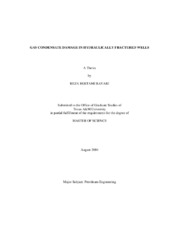Gas condensate damage in hydraulically fractured wells
| dc.contributor.advisor | Schechter, David S. | |
| dc.contributor.advisor | Wattenbarger, Robert A. | |
| dc.creator | Reza, Rostami Ravari | |
| dc.date.accessioned | 2004-11-15T19:46:15Z | |
| dc.date.available | 2004-11-15T19:46:15Z | |
| dc.date.created | 2004-08 | |
| dc.date.issued | 2004-11-15 | |
| dc.identifier.uri | https://hdl.handle.net/1969.1/1100 | |
| dc.description.abstract | This project is a research into the effect of gas condensate damage in hydraulically fractured wells. It is the result of a problem encountered in producing a low permeability formation from a well in South Texas owned by the El Paso Production Company. The well was producing from a gas condensate reservoir. Questions were raised about whether flowing bottomhole pressure below dewpoint would be appropriate. Condensate damage in the hydraulic fracture was expected to be of significant effect. In the most recent work done by Adedeji Ayoola Adeyeye, this subject was studied when the effects of reservoir depletion were minimized by introduction of an injector well with fluid composition the same as the original reservoir fluid. He also used an infinite conductivity hydraulic fracture along with a linear model as an adequate analogy. He concluded that the skin due to liquid build-up is not enough to prevent lower flowing bottomhole pressures from producing more gas. This current study investigated the condensate damage at the face of the hydraulic fracture in transient and boundary dominated periods when the effects of reservoir depletion are taken into account. As a first step, simulation of liquid flow into the fracture was performed using a 2D 1-phase simulator in order to help us to better understand the results of gas condensate simulation. Then during the research, gas condensate models with various gas compositions were simulated using a commercial simulator (CMG). The results of this research are a step forward in helping to improve the management of gas condensate reservoirs by understanding the mechanics of liquid build-up. It also provides methodology for quantifying the condensate damage that impairs linear flow of gas into the hydraulic fracture. | en |
| dc.format.extent | 1364620 bytes | en |
| dc.format.extent | 165025 bytes | en |
| dc.format.medium | electronic | en |
| dc.format.mimetype | application/pdf | |
| dc.format.mimetype | text/plain | |
| dc.language.iso | en_US | |
| dc.publisher | Texas A&M University | |
| dc.subject | gas condensate | en |
| dc.subject | condensate damage | en |
| dc.subject | condensate | en |
| dc.subject | condensate damage in hydraulically fractured well | en |
| dc.title | Gas condensate damage in hydraulically fractured wells | en |
| dc.type | Book | en |
| dc.type | Thesis | en |
| thesis.degree.department | Petroleum Engineering | en |
| thesis.degree.discipline | Petroleum Engineering | en |
| thesis.degree.grantor | Texas A&M University | en |
| thesis.degree.name | Master of Science | en |
| thesis.degree.level | Masters | en |
| dc.contributor.committeeMember | Moroney, John R. | |
| dc.type.genre | Electronic Thesis | en |
| dc.type.material | text | en |
| dc.format.digitalOrigin | born digital | en |
Files in this item
This item appears in the following Collection(s)
-
Electronic Theses, Dissertations, and Records of Study (2002– )
Texas A&M University Theses, Dissertations, and Records of Study (2002– )


